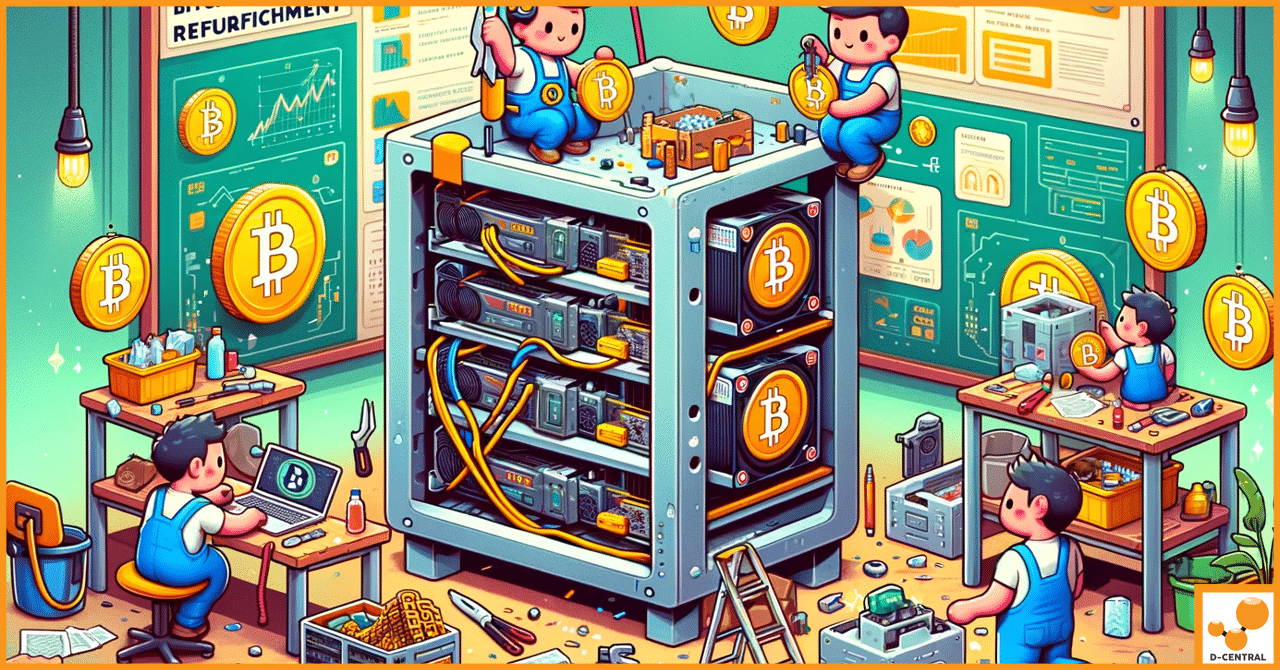
Essential Questions to Ask Your Managed Hosting Provider for Optimal Bitcoin Mining Operations
In the dynamic world of Bitcoin mining, the choice of a managed hosting provider is a pivotal decision that can
4479 Desserte Nord Autoroute 440, Laval, QC H7P 6E2

In the ever-evolving landscape of digital currencies, Bitcoin stands as a pioneering force, driving the adoption and acceptance of cryptocurrencies worldwide. Central to its operation and the very fabric of its existence is the process of Bitcoin mining. This intricate procedure is not only foundational in generating new Bitcoin but also crucial in maintaining and securing the blockchain network. Mining involves solving complex computational problems, a task that requires significant processing power and, as a result, specialized hardware known as ASIC (Application-Specific Integrated Circuit) miners. These powerful machines are at the heart of the mining process, offering the speed and efficiency required to navigate the Bitcoin network’s demanding computational landscape.
However, the relentless pursuit of Bitcoin mining has its consequences. ASIC miners, despite their robust design and advanced capabilities, are not immune to the physical wear and tear brought about by constant operation. Over time, these machines can suffer from reduced efficiency, increased energy consumption, and eventual failure, posing challenges to their operators’ quest for Bitcoin and the broader health of the mining ecosystem. It’s here that the concept of mining machine refurbishment gains paramount importance.
Refurbishing Bitcoin mining hardware extends beyond simple repairs, embodying a comprehensive process aimed at restoring, upgrading, and optimizing these machines to a state of like-new performance. This practice not only breathes new life into aging hardware but also presents a sustainable alternative to the continuous cycle of purchasing new equipment. By refurbishing mining machines, operators can significantly reduce electronic waste, lower operational costs, and improve their overall mining profitability. Moreover, in an industry increasingly scrutinized for its environmental impact, the refurbishment of mining hardware stands as a testament to the crypto community’s commitment to sustainability. Thus, mining machine refurbishment emerges as a crucial endeavor, balancing the scales between relentless technological advancement and the pressing need for environmental stewardship and operational efficiency within the cryptocurrency world.
The crypto mining industry, with its relentless quest for efficiency and profitability, operates on the cutting edge of technology. At the heart of this operation are ASIC (Application-Specific Integrated Circuit) miners, designed exclusively for mining cryptocurrencies such as Bitcoin. These machines are the workhorses of the mining world, offering unparalleled processing power to navigate the complex algorithms that secure the blockchain. However, the lifecycle of ASIC mining hardware is a testament to the harsh realities of continuous, high-intensity operation.
ASIC miners are engineered for peak performance, but like all electronic equipment, they are subject to wear and tear. The relentless demand placed on these machines, operating 24/7 in various environmental conditions, inevitably leads to physical and operational degradation. Heat, one of the most significant byproducts of continuous operation, poses a substantial risk, gradually impairing hardware efficiency and longevity. Dust accumulation and mechanical fatigue further exacerbate the situation, leading to reduced hash rates, increased error rates, and, ultimately, machine failure. These factors, compounded over time, delineate a lifecycle that swings from peak efficiency to diminished returns, signaling the need for intervention.
The refurbishment of ASIC mining hardware emerges as a compelling solution to this dilemma, offering both environmental and economic benefits that resonate with the ethos of sustainability and efficiency that is increasingly important in the crypto industry.
Environmental Benefits: Refurbishing ASIC miners addresses key environmental concerns head-on. By extending the life of existing hardware, the need for producing new units is reduced, thereby lowering the carbon footprint associated with manufacturing processes. This approach significantly contributes to reducing electronic waste, a growing issue as outdated or broken miners find their way into landfills. Through refurbishment, components are reused and recycled, promoting a circular economy within the tech industry, where resources are maximized, and waste is minimized.
Economic Benefits: From an economic perspective, refurbishment offers miners a cost-effective alternative to the continuous cycle of purchasing new equipment. The cost of a new ASIC miner can be prohibitive, representing a significant capital investment that is at risk of obsolescence in the face of rapid technological advancements. Refurbishment not only restores machines to their optimal operational state but does so at a fraction of the cost of new hardware. This cost efficiency extends to energy consumption as well; refurbished machines often benefit from upgrades that enhance energy efficiency, reducing operational costs and increasing profitability in an industry where margins can be thin.
In summary, the refurbishment of ASIC mining hardware presents a strategic response to the challenges of wear and tear, economic pressures, and environmental concerns. By embracing refurbishment, the crypto mining industry can ensure the sustainability of its operations, safeguarding profitability while upholding a commitment to environmental stewardship. This approach not only benefits individual miners and mining operations but contributes to the broader goal of sustainable development within the global tech community.
In the intricate world of cryptocurrency mining, ASIC (Application-Specific Integrated Circuit) miners hold a pivotal position, especially in the mining of Bitcoin, the first and most well-known cryptocurrency. These specialized devices are engineered with a singular focus: to mine cryptocurrencies as efficiently as possible. Understanding the role of ASIC miners and how they have revolutionized cryptocurrency mining requires a dive into their operational mechanics and comparative performance against other mining hardware.
ASIC miners are hardware systems specifically designed to perform the hashing functions required in cryptocurrency mining. Unlike general-purpose hardware like CPUs (Central Processing Units) or GPUs (Graphics Processing Units), ASIC miners are optimized to execute the specific cryptographic algorithms used in the mining process of a particular cryptocurrency, such as Bitcoin’s SHA-256 algorithm. This specialization allows ASIC miners to offer unparalleled efficiency and performance in their designated mining tasks.
The preference for ASIC miners in Bitcoin mining stems from their superior efficiency and hashing power compared to other mining hardware. Early in Bitcoin’s history, mining was possible using CPUs and later GPUs, as the difficulty level of mining was relatively low. However, as the Bitcoin network grew and the difficulty of mining increased, the need for more specialized and powerful equipment became apparent. ASIC miners emerged as the solution, offering the following advantages:
The distinction between ASIC miners and other forms of mining hardware lies in their design philosophy and operational efficiency:
ASIC miners have become the standard in Bitcoin mining due to their unmatched efficiency and performance. Their introduction has not only elevated the computational requirements for profitable mining operations but also underscored the technological arms race in cryptocurrency mining hardware development. As the backbone of Bitcoin mining, ASIC miners exemplify the intersection of specialized hardware with the decentralized ethos of cryptocurrency, driving both the security and the advancement of the blockchain network.
Refurbishing ASIC miners is a meticulous process that extends the life and improves the efficiency of these essential devices in cryptocurrency mining. Here’s a detailed look at each step involved in the refurbishment process.
Techniques for Diagnosing Common Issues with ASIC Miners: The refurbishment journey begins with a comprehensive initial assessment and diagnostic phase. Technicians employ a variety of techniques to identify issues, including visual inspections for physical damage, software diagnostics to check for firmware or operational anomalies, and thermal imaging to detect overheating components.
Importance of Initial Assessment in Determining the Refurbishment Strategy: This initial step is crucial as it helps define the scope of refurbishment required. It determines whether a miner needs minor repairs, component replacements, or more extensive refurbishments, thereby setting the course for the subsequent steps in the refurbishment process.
Detailed Walkthrough of the Cleaning Process: Cleaning involves carefully disassembling the ASIC miner to remove dust, debris, and any other contaminants that could impede performance. This may include using compressed air to blow out dust from the cooling fins and heat sinks, and applying specialized cleaning agents to remove grime from the circuit boards and components.
Discussion on the Disassembly Process: Disassembly not only facilitates thorough cleaning but also allows technicians to inspect each component more closely. This step is critical for identifying wear and tear that might not be apparent in an assembled unit, such as subtle signs of corrosion or damage on the PCB (Printed Circuit Board).
Identifying and Replacing Worn or Faulty Components: After cleaning, each component is inspected for signs of wear, damage, or failure. Key components like fans, power supplies, and ASIC chips are checked meticulously. Faulty or worn-out parts are replaced with genuine or equivalent quality components to ensure the miner’s reliability and efficiency.
The Role of Component Inspection in Ensuring the Longevity of the Refurbished Miner: This step ensures that only components in good working condition are used in the refurbished unit, significantly extending its operational life and reducing the likelihood of future failures.
Importance of Firmware Updates: Updating the firmware is a critical step in refurbishment. Firmware updates can fix known bugs, enhance security features, and sometimes even improve the efficiency and speed of mining operations.
How Software Upgrades Contribute to Enhanced Performance: Beyond firmware, software upgrades to the mining management software can introduce new features, improve user experience, and optimize mining performance. These upgrades ensure that the refurbished ASIC miner operates at its best, compatible with current mining protocols and networks.
Replacing or Repairing the Power Supply Unit: The power supply unit (PSU) is crucial for efficient and stable miner operation. A refurbished or new PSU may be installed to ensure the miner operates within the optimal power efficiency range, reducing energy consumption and operational costs.
Upgrading the Thermal Management System: Overheating is a common issue that can reduce the lifespan and efficiency of ASIC miners. The refurbishment process often includes enhancing the thermal management system, such as improving the heat sink design, replacing thermal paste, or installing more efficient cooling fans, to ensure stable operation under load.
Rigorous Testing Procedures: Once refurbished, the ASIC miner undergoes a series of rigorous tests to ensure it meets or exceeds original factory specifications. This includes stress testing under operational conditions, verifying hash rates, and ensuring stability over extended periods.
Performance Benchmarks: Setting performance benchmarks is essential to guarantee the operational efficacy of the refurbished unit. These benchmarks ensure the miner operates efficiently, contributing to the overall profitability of mining operations.
The Impact of Cosmetic Enhancements: While cosmetic enhancements may not directly affect mining performance, they do add value by improving the appearance of the refurbished equipment, making it more appealing to buyers and potentially increasing its resale value.
Packaging and Preparing the Refurbished Unit for Return to the Customer: The final step in the refurbishment process is to carefully package the ASIC miner, ensuring it is securely prepared for shipping. This includes applying anti-static packaging to protect sensitive components and providing the necessary documentation for the refurbished unit.
Through this detailed refurbishment process, ASIC miners are restored to their optimal condition, offering miners a sustainable and efficient alternative to purchasing new equipment. This not only benefits the individual miner but also contributes to the broader goals of environmental sustainability and economic efficiency within the cryptocurrency mining industry.
The refurbishment of mining hardware, particularly ASIC miners, is a critical process in extending the lifecycle of mining equipment and ensuring the sustainability of cryptocurrency mining operations. However, this process is not without its challenges, ranging from sourcing components to managing complex repairs. Here, we explore these challenges and the innovative solutions and technologies that are paving the way for the future of mining hardware refurbishment.
Sourcing Components: One of the primary challenges in refurbishing mining hardware is the difficulty in sourcing high-quality, compatible components. The rapid pace of technological advancement in ASIC miners means that components can quickly become obsolete, making them hard to find. Additionally, the need for components that meet the original manufacturer’s specifications for performance and reliability adds another layer of complexity.
Managing Complex Repairs: ASIC miners are sophisticated pieces of equipment composed of intricate electronic circuits and specialized components. Repairing these devices requires a high level of technical expertise and precision. Complex repairs, such as those involving the ASIC chips themselves or the printed circuit board (PCB), can be particularly challenging, requiring specialized equipment and skills.
Advanced Diagnostic Tools: To address the challenge of diagnosing issues with ASIC miners, refurbishment centers are increasingly turning to advanced diagnostic tools that can quickly and accurately identify problems. These tools include software diagnostics that can run through the miner’s firmware, hardware diagnostics tools for testing components at the circuit level, and thermal imaging cameras to identify overheating issues.
3D Printing for Component Manufacturing: 3D printing technology offers a promising solution to the challenge of sourcing obsolete or hard-to-find components. With the ability to produce parts on demand, refurbishment centers can create specific components that are no longer available on the market, ensuring that miners can be restored to full functionality without the need for compromises on quality or performance.
Collaboration with Manufacturers: Some refurbishment centers are forging partnerships with ASIC miner manufacturers to ensure a steady supply of genuine components. These collaborations can also facilitate the sharing of technical documentation and firmware updates, enhancing the quality and efficiency of the refurbishment process.
Specialized Training Programs: Given the complexity of ASIC miner repairs, there is a growing focus on specialized training programs for technicians. These programs, often developed in collaboration with manufacturers or specialized training institutions, are designed to equip technicians with the skills needed to tackle complex repairs, including micro-soldering, PCB repair, and ASIC chip reballing.
Automated Testing and Calibration Systems: To ensure that refurbished ASIC miners meet the required performance and efficiency standards, refurbishment centers are employing automated testing and calibration systems. These systems can run a series of tests on the miners under various operational conditions, ensuring that each unit is calibrated for optimal performance before it is returned to the customer.
Environmental Considerations: In response to the growing emphasis on sustainability, some refurbishment centers are implementing environmentally friendly practices in their operations. This includes recycling components where possible, using eco-friendly cleaning agents, and implementing energy-efficient refurbishment processes.
The refurbishment of mining hardware is a complex but essential process that addresses the sustainability and efficiency challenges of cryptocurrency mining. While the process faces several challenges, including sourcing components and managing complex repairs, innovative solutions and technologies are emerging that promise to shape the future of mining hardware refurbishment. By embracing these advancements, refurbishment centers can not only overcome the challenges but also significantly contribute to the longevity and profitability of mining operations, all while supporting environmental sustainability.
In the fast-paced and technically demanding world of cryptocurrency mining, the role of professional ASIC repair services cannot be overstated. These specialized centers, such as D-Central, offer a lifeline to miners by providing comprehensive repair and refurbishment services that are crucial for maintaining the efficiency and longevity of mining operations. Understanding the range of services offered by these centers and the importance of selecting a reputable provider is essential for anyone involved in cryptocurrency mining.
Professional ASIC repair centers like D-Central offer a broad spectrum of services designed to address every aspect of miner maintenance and repair. These services include but are not limited to:
Selecting a reputable and experienced ASIC repair service provider is crucial for several reasons:
The role of professional ASIC repair services in the cryptocurrency mining industry is indispensable. They not only ensure the operational efficiency and longevity of ASIC miners but also support the broader goals of sustainability and profitability in mining operations. Miners looking to maintain their hardware in peak condition should prioritize selecting a reputable and experienced service provider, like D-Central, that offers comprehensive repair and maintenance services tailored to the unique demands of cryptocurrency mining.
The refurbishment of Bitcoin mining machines represents a critical and strategic approach towards ensuring the sustainability, efficiency, and profitability of cryptocurrency mining operations. As we have explored, the process of refurbishing ASIC miners extends beyond mere repair, embodying a comprehensive renewal that breathes new life into these essential devices. The benefits of opting for refurbishment are manifold, offering both economic and environmental advantages that align with the broader goals of the cryptocurrency community.
We strongly encourage miners to consider refurbishment as a viable and advantageous option. Not only does it represent a step towards more sustainable mining practices, but it also provides a pathway to enhancing the performance and longevity of your mining equipment in a cost-effective manner.
For those interested in exploring the possibilities of refurbishing their Bitcoin mining machines, professional refurbishment services stand ready to provide assessments, quotes, and expert advice. These specialists possess the knowledge, skills, and resources required to revitalize your mining hardware, ensuring that it continues to operate at peak efficiency.
We invite you to contact professional refurbishment services to understand more about how your mining operations can benefit from this essential service. Furthermore, we encourage you to explore our website for additional information on refurbishment services and to get in touch with our experts for personalized advice tailored to your specific needs and circumstances.
Embracing refurbishment is not just a choice for operational excellence; it’s a commitment to sustainable and responsible mining practices that benefit not only individual miners but the cryptocurrency ecosystem as a whole.
What is Bitcoin mining?
Bitcoin mining is the process that involves solving complex computational problems to generate new Bitcoin and maintain the blockchain network. This requires specialized hardware known as ASIC miners, which provide the necessary processing power.
Why is refurbishment important in crypto mining?
Refurbishment is crucial in crypto mining as it extends the lifespan of ASIC miners, reduces electronic waste, lowers operational costs, and improves mining profitability. It also supports the industry’s shift towards more sustainable practices.
What are the environmental and economic benefits of refurbishing ASIC miners?
The environmental benefits include reducing electronic waste and lowering the carbon footprint associated with producing new units. Economically, refurbishment offers a cost-effective alternative to buying new equipment, as it restores machines to optimal condition at a fraction of the cost.
What does the refurbishment process involve?
The refurbishment process involves assessing and diagnosing the miner, cleaning and disassembling it, inspecting and replacing components, updating firmware and software, overhauling the power supply and thermal management system, and conducting rigorous quality control tests.
What challenges are involved in mining hardware refurbishment?
Challenges include sourcing compatible components for repair, managing complex repairs due to the sophistication of ASIC miners, and ensuring reparations meet high-quality standards. Solutions involve using advanced diagnostic tools, 3D printing for components, and specialized training for technicians.
Why should I choose a professional ASIC repair service?
A professional ASIC repair service offers quality repairs using genuine components, technical expertise for complex issues, warranties on repairs, cost-effectiveness over the long term, and support eco-friendly practices, contributing to the sustainability of the mining industry.
How can refurbishment contribute to sustainable cryptocurrency mining?
Refurbishment contributes to sustainable cryptocurrency mining by reducing the demand for new mining equipment, minimizing waste, and promoting the reuse of components, thereby aligning operations with environmental sustainability goals.
DISCLAIMER: D-Central Technologies and its associated content, including this blog, do not serve as financial advisors or official investment advisors. The insights and opinions shared here or by any guests featured in our content are provided purely for informational and educational purposes. Such communications should not be interpreted as financial, investment, legal, tax, or any form of specific advice. We are committed to advancing the knowledge and understanding of Bitcoin and its potential impact on society. However, we urge our community to proceed with caution and informed judgment in all related endeavors.
Related Posts

In the dynamic world of Bitcoin mining, the choice of a managed hosting provider is a pivotal decision that can

The world of public Bitcoin mining has undergone a seismic shift, especially in the wake of a bearish 2022. This

In the ever-evolving world of investments, Bitcoin and Real Estate stand out as two fundamentally distinct options, each with its